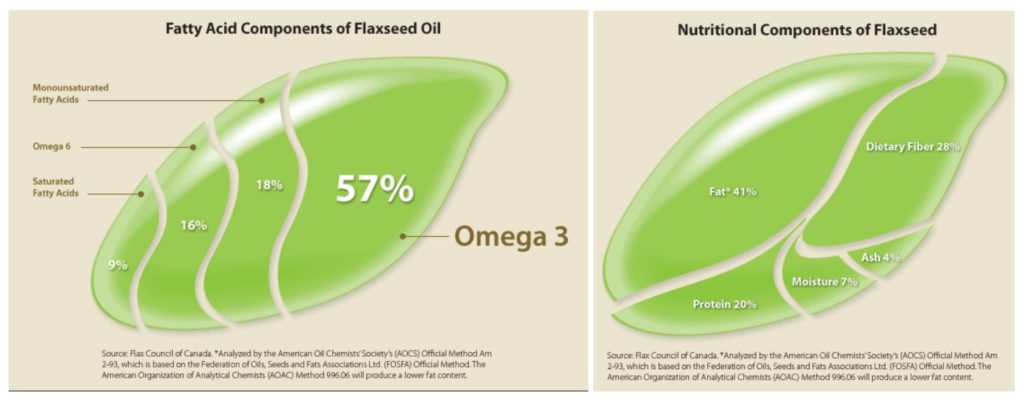
There are a wide number of reasons why it’s a pretty good idea to add flaxseeds to your food shopping list, whether or not you’re eating a plant-based diet. These little seeds are a powerhouse of goodness. If, as a result of reading this blog, you’re encouraged to include them in your daily diet, then I’ll be pretty confident that, in a small way, I’ve helped you towards a longer and healthier life.
Blog Contents
Is flaxseed the same as linseed?
If you enter either word in Wikipedia, you get exactly the same page. I guess this indicates that they are, to all intents and purposes, the same thing – members of the plant family Linaceae and the genus Linum. Whilst there are variations within the genus, the only major difference you’ll notice is that the seeds can be either brown or golden (yellow) in colour.
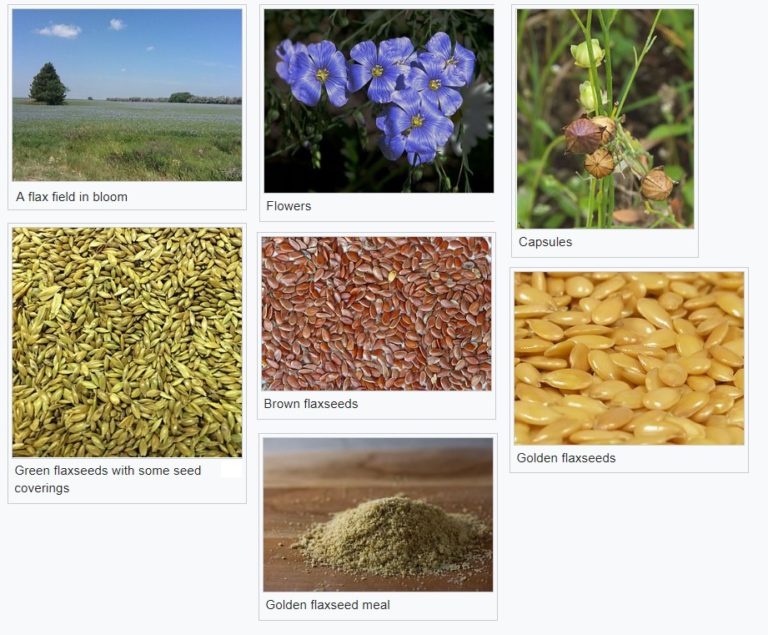
Although fibrous parts of the flax plant are used for various purposes (including making clothing), and you’ll know about the uses of linseed oil (including protecting cricket bats), we’ll just concentrate on the linseed/flaxseeds themselves, which will be herein referred to as flaxseeds for the sake of brevity. By the way, my advice is to avoid consuming any the the oil prepared from flaxseeds, for the same reason as all oils are to be avoided 1 . Instead, just stick to the seeds.
Why do flaxseeds need to be ground?
Unlike most seeds, the outer protective shell of each tiny flaxseed is so tough that eating them whole will mean they ‘cut out the middle man’ and end up, intact, in the toilet bowl. By grinding them, all the wonderful goodness is released. I go into this in a bit more detail later.
What’s the nutritional value of flaxseeds?
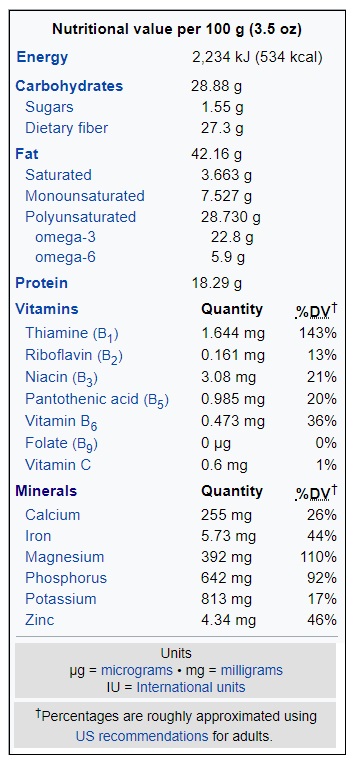
Most flaxseeds have an almost identical nutritional profile, with the same number of omega-3 fatty acids. This makes them a really important part of any plant-based diet. There is, however, one variant of yellow flax (solin, usually under the trade name “Linola”) which is very low in omega-3 fatty acids. Fibre, protein, and fat profiles are excellent.
You’ll see from the nutritional value chart 2 that there are also plenty of vitamins and minerals in flaxseeds. But the good news doesn’t end there. Of all the individual so-called ‘super foods’ that you could think of, flaxseeds will be right up there at the top. The lignan content is just one weapon in their disease-fighting armoury. Essential fatty acids (ALA and AA) and fibre content are also remarkably high. To give you an idea of just how amazing the bundle of compounds in flaxseeds really are, the following is a list of some of the health benefits that these amazing little fellas may offer:
- lowering blood pressure 3 , hence:
- fighting cancer
- lowering blood cholesterol levels 10
- reducing blood triglyceride levels 11
- reducing blood sugar levels/insulin resistance/diabetes risk 12 13 14
- reducing inflammation 15 16
- preventing/treating constipation 17
- reducing body weight/BMI 18
- preventing osteoporosis/bone loss 19 20
- preventing arthritis 21
- improving skin health/healing 22
- reducing number of menstrual periods 23
Omega-3 & flaxseeds
As I’ve pointed out in previous blogs, flaxseeds 24 25 and chia seeds 26 (along with walnuts) are probably the best non-fish sources of omega-3’s for those eating a plant-based diet. The long-chain polyunsaturated fatty acid (LC-PUFA) ALA (alpha-linolenic acid) is an essential fatty acid which we need to get from our diet since the human body can’t synthesise it on its own. When sufficient ALA is provided in the diet, the body can use it to make the longer-chain PUFA’s, DHA (docosahexaenoic acid) and EPA (eicosapentaenoic acid), both of which are essential for our health. 27
The following diagrams illustrate the high levels of omega-3 oils in flaxseeds:
What are lignans?
From the Latin for “wood” (lign-) plus the chemical suffix”-an”, lignans found in plants are a form of micronutrient called polyphenols 28 . In order for the plant lignans29 to be used by the human body, they have to be metabolised by our gut bacteria into the mammalian lignans called enterodiol and enterolactone (known as enterolignans – from the Greek énteron meaning intestine). So, plant lignans can be described as “lignan precursors” for our human versions.
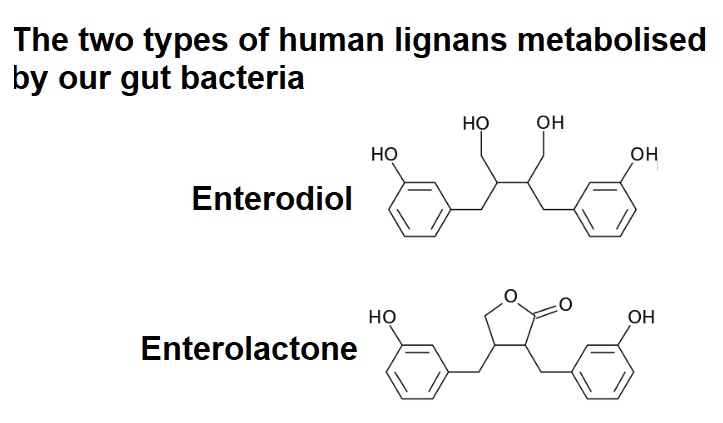
Lignans are one of the major classes of phytoestrogens30 – oestrogen-like chemicals (found in foods like beans, seeds and grains) that also act as antioxidants. You’ll hear some comments on the internet that phytoestrogens are dangerous because they bind to and block important oestrogen receptors; however, this does not appear to be the case, since there are two different forms of oestrogen receptor, and phytoestrogens do not block those to which oestrogen normally attaches. Additionally, evidence exists 31 that they can help prevent cardiovascular diseases, diabetes and cancer of the breast, brain, colon, liver, ovaries and skin. They also appear to reduce LDL (“bad”) cholesterol and aid weight loss. While phytoestrogens found in plants do not decrease male fertility, the xenoestrogens 32, which, in terms of diet, are found mainly in fish, have been shown to drastically lower sperm count and cause early puberty.
Whilst the above long list 33 of health benefits offered by flaxseeds is, of course, also partly attributable to the other essential fatty acids, minerals, vitamins and phytochemicals they contain, the lignan content is especially powerful. Trying to decide exactly what each individual compound does is a really tough task, and perhaps not always necessary. After all, the compounds do not exist in isolation within plants and neither do they work in isolation within our bodies. Trying to pinpoint active compounds is something that pharmaceutical companies love to do, since they can then bottle them and sell them at high price, even though they often don’t work as they did when the compound was in its natural position within the complex of the original plant.
We’ve looked at the issue of wholism vs reductionism in a previous blog 34 . So, whether the cardiovascular protection afforded by flaxseeds is x% due to the omega-3, y% due to the fibre, and z% due to the lignans is, as far as I’m concerned, a secondary matter to what the whole seed is capable of doing with all three elements, plus the others we know about and the many we still haven’t even identified. And this doesn’t even touch on the vast array of interactions between these elements and the likelihood that there will be some variation between the physiology of individual humans – particularly in relation to the microbiome (gut, urinary, oral, etc) that our diets and lifestyles have provided us with.
In terms of lignans, why are flaxseeds so remarkable?
The type of lignans found in flaxseeds are not the only dietary lignans – others include sesamin 35 , matairesinol 36 , pinoresinol 37 and lariciresinol 38 . The main lignan in flaxseeds (as well as in sunflower, sesame, and pumpkin seeds) has the unpronounceable name “secoisolariciresinol diglucoside” or SDG for short. Regardless of the source of SDG, once it’s ingested, it’s “…converted in the colon into active mammalian lignans, enterodiol, and enterolactone, which have shown promise in reducing growth of cancerous tumors, especially hormone‐sensitive ones such as those of the breast, endometrium, and prostate. Known for their hydrogen‐donating antioxidant activity as well as their ability to complex divalent transition metal cations, lignans are propitious to human health.” 39 . All well and good, but the remarkable thing about flaxseeds isn’t that the lignans they contain are not found in other seeds, rather it’s because of the incredibly high lignan content these little seeds have. Indeed, you’ll see from the following chart 40 that they contain around 100 times more lignans than almost every other food, with sesame seeds being the closest with 7 times less.
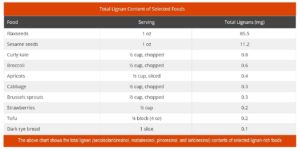
Add to this the fact that Dr Greger claims 41 there are no bad side effects to normal flaxseed consumption 42 – unless, of course, you’re one of the very few who has a flaxseed allergy 43 – and you have as near to a super food as you’re likely to get.
One study compared the results of flaxseeds and flaxseed oil: “SDG [the major type of lignan in flaxseeds] is a potent angiogenic and antiapoptotic agent that may have a role in cardio protection in ischemic heart disease. In conclusion, flaxseed, FLC, and SDG, but not flaxseed oil, suppress atherosclerosis, and FLC [flax lignan complex] and SDG slow progression of atherosclerosis but have no effect on regression. Flaxseed oil suppresses oxygen radical production by white blood cells, prolongs bleeding time, and in higher doses suppresses serum levels of inflammatory mediators and does not lower serum lipids.” 44
No lignans in flaxseed oil
It’s important to note that when you extract pure oil from flaxseeds, the important phytoestrogen lignans are removed 45 . This is another reason why it’s important to consume the whole seed and to generally keep away from extracted flaxseed oil – unless, of course, you want to grease your cricket bat! This rule applies to all extracted oils, of course, as mentioned above.
Flaxseed proteins
The following is a sample of research reviewed within one study 46 showing some of the varied health benefits from the proteins within flaxseeds:
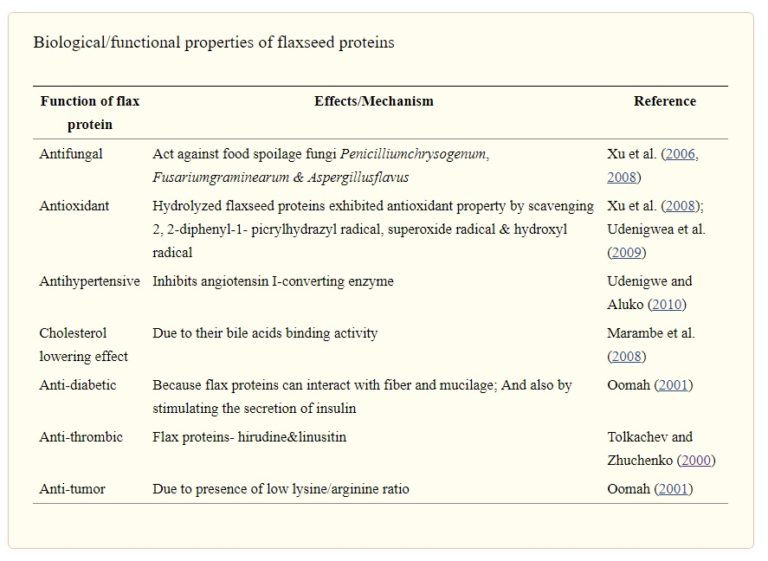
Fatty acids in flaxseeds
The following chart (from the same study as above) indicates the levels of the major fatty acids within flaxseeds:
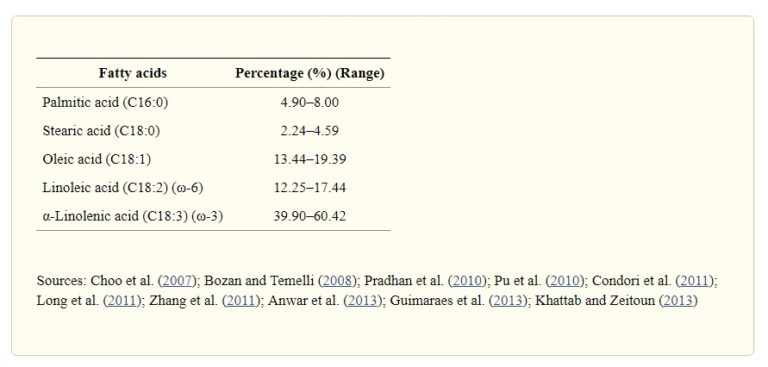
Historical & recent medicinal uses of flaxseeds
The following charts (from the same source as above) indicate some of the distant historical and more recent uses of flaxseeds (in the latter case, from flaxseed oil):
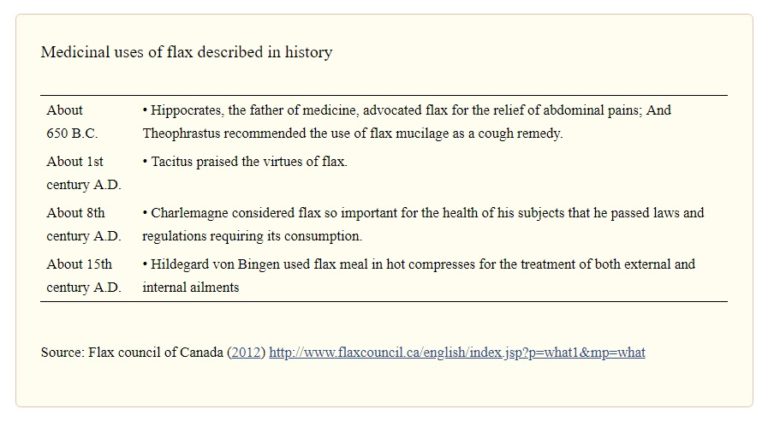
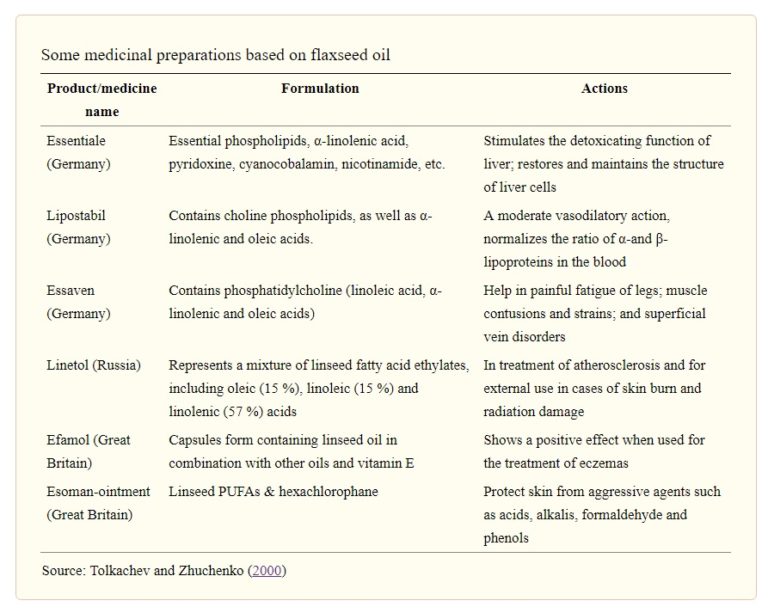
Microbiome & lignans
The nature of your gut bacteria (the intestinal microbiome) will affect how much of the lignan goodness is absorbed and utilised by your body. As one authority states: “It is likely that individual differences in the metabolism of lignans, possibly due to gut microbes, influence the biological activities and health effects of these compounds.” 47 As is the case with so much nutrient metabolism and absorption, having a healthy got microbiome is so important, and, as was shown in an earlier blog 48 a varied plant-based diet (as opposed to a meat- or processed food-based diet) provides by far the healthiest environment for intestinal bacteria.
How much ground flaxseed should we have each day?
Dr Greger can answer this for us. In response to one of the above-mentioned studies, entitled “Flaxseed: A Miraculous Defence Against Some Critical Maladies,” 3 , he states:
“Miraculous”? Well, certainly super healthy, which is why a tablespoon of ground flaxseeds every day gets its own spot on the Daily Dozen checklist 49 I created to help inspire you to incorporate some of the healthiest foods into your daily routine.” 50
You can get your daily tablespoon of ground flaxseeds in so many ways: from mixing it in with your morning muesli to using it as a thickener in soups, stews, etc.
Dr Greger, flaxseeds & lignans
Talking about Dr G, you’d be able to get an idea of just how important a subject is by counting the number of videos he does on that subject. The following are just his most popular of videos which discuss the evidence for the lasting force of lignans and flaxseeds:
-
- Which Are Better: Chia Seeds or Flax Seeds? 51
- Flaxseeds for Hypertension 52
- Can Flaxseeds Help Prevent Breast Cancer? 53
- Flaxseeds for Breast Pain 54
- Flaxseeds & Breast Cancer Survival: Clinical Evidence 55
- Flaxseeds & Breast Cancer Survival: Epidemiological Evidence 56
- Flaxseeds & Breast Cancer Prevention 57
- Just the Flax, Ma’am? 58
- Flaxseeds vs. Prostate Cancer 59
- Flaxseeds vs. Diabetes 60
- Was It the Flaxseeds, Fat Restriction, or Both? 61
- Flaxseeds for Sensitive Skin 62
- Flaxseeds vs. Chia Seeds 63
- Which Are Better: Chia Seeds or Flaxseeds? 64
Final thoughts
It’s hard to believe that such a humble little seed can do so much good, but the evidence is there to support the claims – and the studies I’ve listed are but a small drop in the ocean of the research showing the multifarious benefits. The fact is, that it’s simply hard to over-egg (vegan alternative, of course!) the case for including flaxseed within one’s diet – especially if you’re completely plant-based and just want to ensure you get additional omega-3, along with walnuts.
So, why not make it a regular habit to include at least a tablespoon of flaxseeds in your daily diet?
Perhaps the best way to go about this is to have a supply always at the ready. Buy them whole in bulk. Buying pre-ground flaxseeds is much more expensive and it’s probably best to consume them within not too long a period of time after grinding – and you never know how long the ground version has been sitting on the shop shelf. So, possibly best to grind them yourself in a small coffee grinder and then store a kg of the ground up flaxseeds in a sealed container. So easy to dip into when you want. I also tend to make a weekly supply of muesli in a large container, into which I add ground flaxseeds from my 1kg flaxseed container. Since a tablespoon of flaxseeds weighs around 7 grams, I usually add around 100 grams for the week. Give it a good shake and you’re pretty confident about getting your weekly supply just from the muesli alone.
If it’s any help (although I’m not promoting either company), I buy flaxseeds in bulk (20 x 500 gram bags) from a company called Grapetree 65 . They appear to be one of the cheapest sources.
Additionally, I use a basic (but very effective) coffee grinder called the Duronic CG300 Electric Coffee Grinder Mill 66 , available from Amazon for £29.99. Of course, any coffee grinder will do the job. Just make sure you don’t grind the seeds too much (or you’ll get flaxseed butter) or too little (or you’ll leave intact and indigestible seeds). I tend to grind until the sound of the seeds hitting the top of the grinder stops, then scoop out the ground seeds.

References & Notes
- Olive Oil Injures Endothelial Cells [↩]
- United States Department of Agriculture. Agricultural Research Service. USDA Food Composition Databases: Flaxseeds. [↩]
- Pak J Pharm Sci. 2013 Jan;26(1):199-208. Flaxseed – a miraculous defense against some critical maladies. Akhtar S, Ismail T, Riaz M. [↩] [↩]
- Can J Cardiol. 2010 Nov; 26(9): 489–496.The cardiovascular effects of flaxseed and its omega-3 fatty acid, alpha-linolenic acid. Delfin Rodriguez-Leyva, MD, PhD, Chantal MC Bassett, PhD, Richelle McCullough, BSc, and Grant N Pierce, PhD. [↩]
- Contemp Clin Trials. 2011 May 17. The effect of dietary flaxseed on improving symptoms of cardiovascular disease in patients with peripheral artery disease: rationale and design of the FLAX-PAD randomized controlled trial. Leyva DR, Zahradka P, Ramjiawan B, Guzman R, Aliani M, Pierce GN. [↩]
- Cancer Epidemiol Biomarkers Prev. 2008 Dec; 17(12): 3577–3587. Flaxseed Supplementation (not Dietary Fat Restriction) Reduces Prostate Cancer Proliferation Rates in Men Presurgery. Wendy Demark-Wahnefried, et al. [↩]
- J Med Food. 2013 Apr; 16(4): 357–360. Flaxseed-Derived Enterolactone Is Inversely Associated with Tumor Cell Proliferation in Men with Localized Prostate Cancer. Maria Azrad, et al. [↩]
- L. U. Thompson, J. M. Chen, T. Li, K. Strasser-Weippl, P. E. Goss. Dietary flaxseed alters tumor biological markers in postmenopausal breast cancer. Clin. Cancer Res. 2005 11(10):3828 – 3835 [↩]
- Front Nutr. 2018; 5: 4. The Effect of Flaxseed in Breast Cancer: A Literature Review. Ana Calado, Pedro Miguel Neves, Teresa Santos, Paula Ravasco. [↩]
- Nutr Metab (Lond). 2012; 9: 8. Flaxseed dietary fibers lower cholesterol and increase fecal fat excretion, but magnitude of effect depend on food type. Mette Kristensen, et al. [↩]
- Rev Recent Clin Trials. 2015;10(1):61-7. Effect of flaxseed on blood lipid level in hyperlipidemic patients. Torkan M, Entezari MH, Siavash M. [↩]
- J Res Med Sci. 2016; 21: 70. Published online 2016 Sep 1. The effect of flaxseed powder on insulin resistance indices and blood pressure in prediabetic individuals: A randomized controlled clinical trial Afrooz Javidi, et al. [↩]
- Curr Pharm Des. 2016;22(2):141-4. Flaxseed and Diabetes. Prasad K, Dhar A. [↩]
- Nutr Rev. 2018 Feb 1;76(2):125-139. Flaxseed supplementation on glucose control and insulin sensitivity: a systematic review and meta-analysis of 25 randomized, placebo-controlled trials. Mohammadi-Sartang M, Sohrabi Z, Barati-Boldaji R, Raeisi-Dehkordi H, Mazloom Z. [↩]
- J Am Coll Nutr. 2017 Nov-Dec;36(8):646-653. Influence of Flaxseed Lignan Supplementation to Older Adults on Biochemical and Functional Outcome Measures of Inflammation. Di Y, et al. [↩]
- ISRN Inflamm. 2013; 2013: 735158. Effect of L. usitatissimum (Flaxseed/Linseed) Fixed Oil against Distinct Phases of Inflammation. Gaurav Kaithwas, Dipak K. Majumdar. [↩]
- Nutr Metab (Lond). 2018; 15: 36. A randomized trial of the effects of flaxseed to manage constipation, weight, glycemia, and lipids in constipated patients with type 2 diabetes. Noureddin Soltanian, Mohsen Janghorbani. [↩]
- Obes Rev. 2017 Sep;18(9):1096-1107. The effect of flaxseed supplementation on body weight and body composition: a systematic review and meta-analysis of 45 randomized placebo-controlled trials. Mohammadi-Sartang M, et al. [↩]
- Bioorg Med Chem Lett. 2016 Apr 1;26(7):1760-1. Cyclolinopeptides, cyclic peptides from flaxseed with osteoclast differentiation inhibitory activity. Kaneda T, Yoshida H, Nakajima Y, Toishi M, Nugroho AE, Morita H. [↩]
- Pak J Biol Sci. 2008 Jul 1;11(13):1696-701. Preventive effects of flaxseed and sesame oil on bone loss in ovariectomized rats. Boulbaroud S, Mesfioui A, Arfaoui A, Ouichou A, el-Hessni A. [↩]
- Nutrients. 2016 Mar; 8(3): 136. Effect of Flaxseed Intervention on Inflammatory Marker C-Reactive Protein: A Systematic Review and Meta-Analysis of Randomized Controlled Trials. Guan-Yu Ren, et al. [↩]
- Int J Biol Macromol. 2015 Jan;72:614-23. Flaxseed lignan wound healing formulation: characterization and in vivo therapeutic evaluation. Draganescu D, et al. [↩]
- J Clin Endocrinol Metab. 1993 Nov;77(5):1215-9. Effect of flax seed ingestion on the menstrual cycle. Phipps WR, Martini MC, Lampe JW, Slavin JL, Kurzer MS. [↩]
- Non-Fish Sources of Omega-3 [↩]
- Omega 3 Supplements = Snake Oil [↩]
- Chia Seeds To The Rescue Of Type 2 Diabetics [↩]
- Reprod. Nutr. Dev. 45 (2005) 581–597 581 Conversion of α-linolenic acid to longer-chain polyunsaturated fatty acids in human adults. Graham C. Burdge, Philip C. Calder. Institute of Human Nutrition, University of Southampton, Southampton, UK. [↩]
- Polyphenols are collections of many (hence “poly-“) phenol structural units. Phenols are organic chemical compounds that have a pair of molecular groups stuck together – namely, a phenyl group with the molecular formula −C6H (six carbon atoms and one hydrogen atom) and a hydroxy group with the formula −OH (one oxygen atom and one hydrogen atom). When these bond together it forms a phenol with the formula C6H5OH. [↩]
- Plant lignans include pinoresinol, lariciresinol, secoisolariciresinol, matairesinol, hydroxymatairesinol, syringaresinol and sesamin. [↩]
- The other classes of phytoestrogens are isoflavones and coumestans. [↩]
- nutritionfacts.org. Topic: Phytoestrogens. [↩]
- Xenoestrogens are byproducts of the plastic and pesticide industries. Besides being a component of plastic, they are also found in conventional makeup/cosmetic products, household cleaners, laundry detergents, and some birth control medications. They are also found in sunscreens, chlorine and processed food. Naturally, with all this junk ending up in the oceans and rivers, fish become contaminated and people who eat fish thereby share in that contamination. [↩]
- What’s the nutritional value of flaxseeds? [↩]
- Wholism vs Reductionism – Not Just a War of Words [↩]
- Sesamin is a lignan extracted from sesame seeds and a compound of sesame seed oil. A small amount is in flaxseeds. [↩]
- Matairesinol is a plant lignan. It occurs with secoisolariciresinol in numerous foods such as oil seeds (including flaxseeds), whole grains, vegetables and fruits. [↩]
- Pinoresinol is a lignan found in Styrax sp. and in Forsythia suspensa, as well as in the caterpillar of the cabbage butterfly, Pieris rapae where it serves as a defence against ants. It’s found in foods such as sesame seeds, Brassica vegetables, olive oil, and small amounts in flaxseeds. [↩]
- Lariciresinol is a lignan, a type of phenylpropanoids. In food, it is found in sesame seeds and in Brassica vegetables. It is also found in the bark and wood of white fir. [↩]
- Flaxseed Lignans: Biosynthesis, Metabolism, Antioxidant Activity, Bio‐Active Components, and Health Benefits. Alhassane Touré Xu Xueming. 29 April 2010. [↩]
- Milder IE, Arts IC, van de Putte B, Venema DP, Hollman PC. Lignan contents of Dutch plant foods: a database including lariciresinol, pinoresinol, secoisolariciresinol and matairesinol. Br J Nutr. 2005;93(3):393-402. [↩]
- nutritionfacts.org. Topic: Flax seeds. [↩]
- There are websites that disagree with this, although there are few published studies showing negative effects, and those that do appear to relate more to consuming flax oil – usually called linseed oil. [↩]
- Allergy Asthma Clin Immunol. 2010; 6(Suppl 2): P6. Flax seed allergy in children: an emerging allergen? Andrew O’Keefe, Sandeep Kapur, Gregory Rex, and Wade Watson. [↩]
- J Cardiovasc Pharmacol. 2009 Nov;54(5):369-77. Flaxseed and cardiovascular health. Prasad K. [↩]
- MayoClinic: Flaxseed and flaxseed oil. [↩]
- J Food Sci Technol. 2014 Sep; 51(9): 1633–1653. Flax and flaxseed oil: an ancient medicine & modern functional food. Ankit Goyal, Vivek Sharma, Neelam Upadhyay, Sandeep Gill, Manvesh Sihag. [↩]
- Oregon State University Linus Pauling Institute. Micronutrient Information Center: Lignans. [↩]
- Two Types of Gut Bacteria: Plant Eaters’ & Meat Eaters’ [↩]
- Dr. Greger’s Daily Dozen Checklist. Michael Greger M.D. FACLM March 30th, 2018 Volume 39 [↩]
- nutritionfacts.org. Topics: Flax seeds. [↩]
- Which Are Better: Chia Seeds or Flax Seeds? Michael Greger M.D. FACLM April 7th, 2017 Volume 35 [↩]
- Flax Seeds for Hypertension. [↩]
- Can Flax Seeds Help Prevent Breast Cancer? [↩]
- Flax Seeds for Breast Pain. [↩]
- Flax Seeds & Breast Cancer Survival: Clinical Evidence. [↩]
- Flax Seeds & Breast Cancer Survival: Epidemiological Evidence. [↩]
- Flaxseeds & Breast Cancer Prevention. [↩]
- Just the Flax, Ma’am. Michael Greger M.D. FACLM August 22nd, 2007 Volume 1. [↩]
- Flaxseeds vs. Prostate Cancer. [↩]
- Flax Seeds vs. Diabetes. [↩]
- Was It the Flaxseeds, Fat Restriction, or Both? [↩]
- Flaxseeds for Sensitive Skin. [↩]
- Flax Seeds vs. Chia Seeds. [↩]
- Which Are Better: Chia Seeds or Flax Seeds? [↩]
- Grapetree. Suppliers of flaxseeds. [↩]
- Amazon: Duronic CG300 Electric Coffee Grinder Mill [↩]
